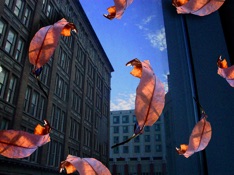standing on marbles

CONTENTS
An Invitation (Appears below)
Introductory Poem: The Desert (appears below)
Three Leadership Types
-
I.Remarkable Leaders
II. Perilous Leaders
III. Toxic Leaders
Commentaries on Poems 99
Artist’s Statement 112
EXCERPT: An Invitation To Standing on Marbles (© 2011 TrueNorth Press)
Standing on Marbles provides an uncommon look into the psyches of some of the most extraordinary business leaders in America. These leaders represent every global sector and a broad array of industries. They also represent a wide spectrum of leadership behavior that I have identified and verified through research as three distinct leadership types: Remarkable, Perilous, and Toxic.
Three Leader Types in Verse and Imagery
Written by Karol M. Wasylyshyn, illustrated with 38 full-color images by Richard McKnight
ISBN: 978-09824683-3-3. 120 pages.
$34.95 Cloth

This image illustrates a poem called “Duende,” Spanish for personal magnetism and charm.

This is a beautiful book. The work is completely unique— truly one of a kind. The poems are provocative, informative of three leader types, and stirred both thought and feeling. The illustrations are amazing, high end art. The book lay out, spacing and use of color make the work highly accessible. The commentary in the back where the poet describes the background behind the poem was very useful to me as I was wondering what the poet was experiencing as she composed each piece. This is stunning and a rare treat.
—Wendy Axelrod
I realize that my identification of these three leadership types may seem simplistic and perhaps even arrogant. My intent is not to oversimplify or to stereotype leaders nor to proffer these types as a definitive representation of leadership styles but rather to examine a truth that most of us who have worked in business organizations know well: there are great leaders, so-so leaders, and terrible ones, too.
With this identification of three leader types, I have put a descriptive stake in the sand. I could have named these leaders colors. I could have named them trees, or animals, or cars. The names of these three leader types matter less than this: running a business is hard and messy and it is often very unsteady—like standing on marbles. Some business executives can do this well; some can learn to do it better; and some will never lead well. Standing on Marbles is a psychologically-informed attempt to help you understand—in a way that is distinct from most books on leaders— the differences among leaders most everyone knows.
My hope is that you will benefit from understanding these three types of leaders, both for your own growth and because you probably have a boss and understanding him or her better can’t hurt. Your understanding will emerge through the stories written here about these three types of leaders—stories based on real people who represent each type. These stories are purposely told through poetry thus leaving all interpretation up to you. While you may turn to the Commentaries at the back of this book to learn of the genesis of each poem, I invite you to stay principally with your own thoughts. I invite you to linger in the white space surrounding each poem—a place where you can reflect about leadership. The person or moment that catalyzed each poem matters infinitely less than what is evoked for you from each story. How you use your reactions to them and the conversations they may spawn with others about leaders is the vehicle for deepening your understanding.
In the spare lines of these poems we are reminded of leaders’ distinctive talents and of their torments as they struggle to maintain balance in the unsteadiness of 21st century business conditions. Their efforts, as revealed through these poems, may comfort, startle, or even stun you. You may have a fond reverie of a Remarkable boss; you may be reminded of the irrational tirades of a Toxic boss. After reading this book, perhaps you can place all of these experiences with leaders into a fuller perspective.
Finally, I am reminded of a conversation I had with the American poet, Ulys H. Yates, who said, “The poet makes the specific universal.” So if you think you recognize yourself in one of these poems, remember you are simultaneously distinct and representative of others who share your leadership type. Also, remember that you are not consistently one of these types. Circumstances can influence your moving along the continuum of Remarkable, Perilous and Toxic behavior—in both your work and personal life. Your special gift to whomever you lead or love is to be Remarkable most of the time. My sincere hope is that Standing on Marbles can help you get there.
Karol M. Wasylyshyn, PsyD
The Desert (Introductory Poem)
I work in a desert that’s parched
and cracked and relentlessly beige.
People get encrusted in sand here,
their ideas scorched, bleached or battered
unless they reach an oasis but even then,
real danger lurks at the well
its stones chipped, and stained by the blood of others
others who lurk mumbling incoherent, lying in wait …
just to throw scorpions under the bench.
I work in a desert that’s as sudden
and inescapable
as the most remarkable people here—
white linen jackets and hats
hats with long canvas flaps down the back
lest the sun bake them dry.
But they’ll not be baked or
distracted by the elements;
instead, they drink the fresh water I pour,
and peel the oranges I’ve
pulled from a deeper pocket.
We feast in unison.
I work in a desert that’s searing by day
and numbing by night.
Camels carry the perilous nomads here—
these nomads half warrior, half ghost
tumble onto the sand
they are thirsty, they are crawling,
they are heaving into the heat,
they have good reason to rest but
they are scraping toward their destinations,
destinations they reach but
are never quite full enough.
I work in a desert that’s as harsh
and repetitive
as the toxic people here—
people who wrap their heads in cloth
when the sandstorms come,
cloth so thick I can’t cut the slits for them to see;
cloths wrapped so tightly that when
the deafening winds roar
they cannot hear—not even their names
names that I’m screaming from the table.
I work in a desert that’s parched
and cracked and relentlessly beige.
Through the winds and the sand and the heat
I still see the people who sent me here …
seasoned stewards of nomads and ghosts;
for them I leave a palette of oils,
an expectant canvas, and a brush—
for whilst I’ve been a guest, they must
keep painting the sands vibrantly.
Directory | Gallery | Books | Photo Blog | Navigator’s (B)log
All artwork and text on this site © 2008, 2009, 2010, 2011. 2012, 2013, 2016, Richard McKnight

